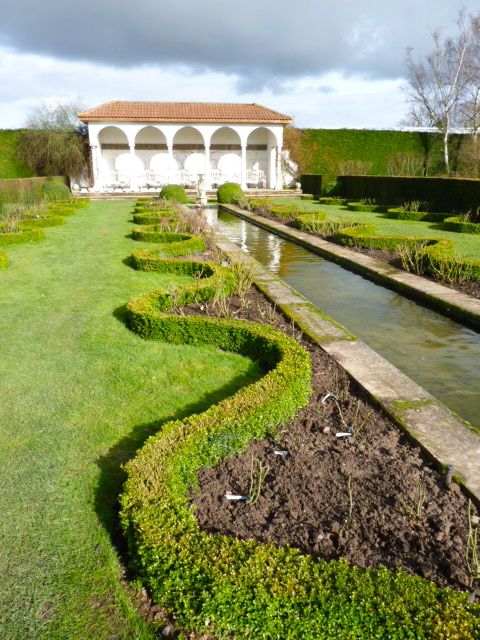
The leaves are off, or nearly, and I’m taking my mind back to David Austin and February. I went there for a day’s course on designing with roses run by the inexorable Diana Perry, fount of rose lore. Due to dog trauma (another story altogether) I did not write a blog log but now I want to tell you about that day and why it was so useful. Forget the design bit, you too can pay and go on the course and have an absolute treat of an outing.
[caption id="attachment_1433" align="alignleft" width="225" caption="detailing of paths"]
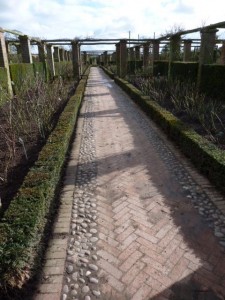
[/caption]
What interests me is the lack of distraction in a garden in the winter months. It is a golden opportunity to concentrate on shape, form, content and construction detail. The bones show themselves. No heady scent and colour, no beguilement of rose faces nodding in passing, just hard tack. The uncluttered beauty is restful, calm and focused.
A perfect opportunity for garnering information and learning. The manmade elements come to the fore. The detailing of the paths, for instance, herringbone brick, edged with flint pebbles. Quite wide too to cope with the summer visitors and bordered by the perfect edging plant. Yew kept drilled to minute tidiness and low size, less than 30 cm tall. I have never seen
Taxus baccata designated to such a controlled place in the garden and I will try this elsewhere.
The secrets of how to treat a rose properly are revealed. It is the dormant season and stems are bare, pruned, trained and tied in. Notebook at the ready, I can go round the David Austin garden and learn how to deal with different types of roses. In particular, the climbing or clambering ones. The exercise is invaluable as most of these grow full spate in the spring and summer and it is impossible to work out how to treat them correctly.
A few photgraphs pass on the knowledge in the most concise way. Rambling roses tend to have whippy, lax and abundant growth. Below is Princess Louise - which is of medium vigour - twined round a brick pillar and ready to grow along the pergola.
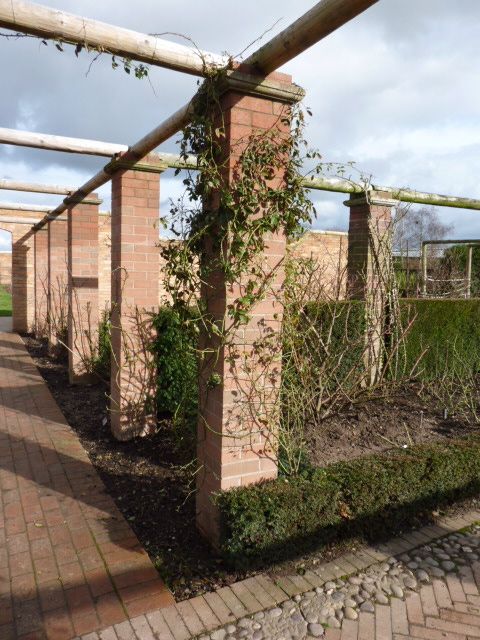
This rose is quite a restrained rambler - it only makes about 5 metres of growth. But remember to treat the rose as defined by it's size. There are ramblers that can grow to 10 or more metres. Check with the nursery before choosing. David Austin have a comprehensive catalogue that gives the height.
For a strong-growing rambler, try the support of pillars linked by heavy ropes or chains hung as festoons. Here is Paul's Himalyan Musk - this one of the beast size of ramblers that can make the 10 metre target - could cover your unsightly shed, pull down the less than vigorous tree:

It is interesting to get a squiny of it in the dormant season. The crazy clawing around of its branches give a good indication of a plant that needs plenty of space.
By contrast, it is handy to look at what could be called a polite climber - the sort that does not throw massive green branches out in gawky fashion midsummer, knows its place, so to speak. David Austin has specialised in breeding such types and so below is The Generous Gardener - base and top:
[caption id="attachment_1440" align="aligncenter" width="480" caption="The Generous Gardener, how to prune"]
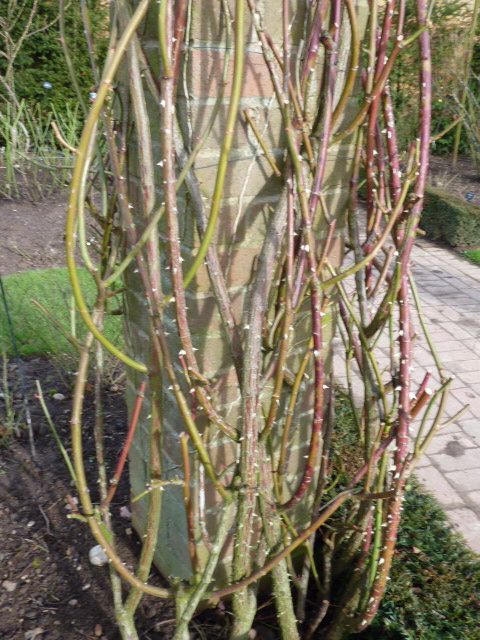
[/caption]
Climbers tend to be much more military and upright in growth. They do not usually have trusses of flowers and quite often they repeat flower. The image of the base of the Generous Gardener shows the new stems, fresh and red and closely tied in . The oldest wood will the be the thickest and hoariest and a few stems can be taken out to encourage the new growth.
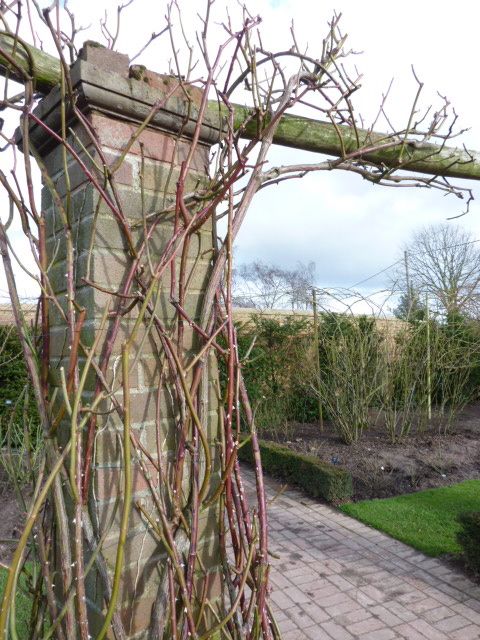
And then at the head of the rose - and this one is listed as only making about 3 metres growth, it is neat and tidy after a prune during the winter months. New shoots can then be trained in along the wooden struts as they grow. This will be excellent for a good show of flowers. Forcing the branches to go sideways will promote the formation of buds and blooms.
Visit gardens in winter and you will learn a good deal. The added bonus for roses is that of course it is the best time to buy them as winter is the time for lifting and despatching bare rooted.
 The leaves are off, or nearly, and I’m taking my mind back to David Austin and February. I went there for a day’s course on designing with roses run by the inexorable Diana Perry, fount of rose lore. Due to dog trauma (another story altogether) I did not write a blog log but now I want to tell you about that day and why it was so useful. Forget the design bit, you too can pay and go on the course and have an absolute treat of an outing.
[caption id="attachment_1433" align="alignleft" width="225" caption="detailing of paths"]
The leaves are off, or nearly, and I’m taking my mind back to David Austin and February. I went there for a day’s course on designing with roses run by the inexorable Diana Perry, fount of rose lore. Due to dog trauma (another story altogether) I did not write a blog log but now I want to tell you about that day and why it was so useful. Forget the design bit, you too can pay and go on the course and have an absolute treat of an outing.
[caption id="attachment_1433" align="alignleft" width="225" caption="detailing of paths"] [/caption]
What interests me is the lack of distraction in a garden in the winter months. It is a golden opportunity to concentrate on shape, form, content and construction detail. The bones show themselves. No heady scent and colour, no beguilement of rose faces nodding in passing, just hard tack. The uncluttered beauty is restful, calm and focused.
A perfect opportunity for garnering information and learning. The manmade elements come to the fore. The detailing of the paths, for instance, herringbone brick, edged with flint pebbles. Quite wide too to cope with the summer visitors and bordered by the perfect edging plant. Yew kept drilled to minute tidiness and low size, less than 30 cm tall. I have never seen Taxus baccata designated to such a controlled place in the garden and I will try this elsewhere.
The secrets of how to treat a rose properly are revealed. It is the dormant season and stems are bare, pruned, trained and tied in. Notebook at the ready, I can go round the David Austin garden and learn how to deal with different types of roses. In particular, the climbing or clambering ones. The exercise is invaluable as most of these grow full spate in the spring and summer and it is impossible to work out how to treat them correctly.
A few photgraphs pass on the knowledge in the most concise way. Rambling roses tend to have whippy, lax and abundant growth. Below is Princess Louise - which is of medium vigour - twined round a brick pillar and ready to grow along the pergola.
[/caption]
What interests me is the lack of distraction in a garden in the winter months. It is a golden opportunity to concentrate on shape, form, content and construction detail. The bones show themselves. No heady scent and colour, no beguilement of rose faces nodding in passing, just hard tack. The uncluttered beauty is restful, calm and focused.
A perfect opportunity for garnering information and learning. The manmade elements come to the fore. The detailing of the paths, for instance, herringbone brick, edged with flint pebbles. Quite wide too to cope with the summer visitors and bordered by the perfect edging plant. Yew kept drilled to minute tidiness and low size, less than 30 cm tall. I have never seen Taxus baccata designated to such a controlled place in the garden and I will try this elsewhere.
The secrets of how to treat a rose properly are revealed. It is the dormant season and stems are bare, pruned, trained and tied in. Notebook at the ready, I can go round the David Austin garden and learn how to deal with different types of roses. In particular, the climbing or clambering ones. The exercise is invaluable as most of these grow full spate in the spring and summer and it is impossible to work out how to treat them correctly.
A few photgraphs pass on the knowledge in the most concise way. Rambling roses tend to have whippy, lax and abundant growth. Below is Princess Louise - which is of medium vigour - twined round a brick pillar and ready to grow along the pergola.
 This rose is quite a restrained rambler - it only makes about 5 metres of growth. But remember to treat the rose as defined by it's size. There are ramblers that can grow to 10 or more metres. Check with the nursery before choosing. David Austin have a comprehensive catalogue that gives the height.
For a strong-growing rambler, try the support of pillars linked by heavy ropes or chains hung as festoons. Here is Paul's Himalyan Musk - this one of the beast size of ramblers that can make the 10 metre target - could cover your unsightly shed, pull down the less than vigorous tree:
This rose is quite a restrained rambler - it only makes about 5 metres of growth. But remember to treat the rose as defined by it's size. There are ramblers that can grow to 10 or more metres. Check with the nursery before choosing. David Austin have a comprehensive catalogue that gives the height.
For a strong-growing rambler, try the support of pillars linked by heavy ropes or chains hung as festoons. Here is Paul's Himalyan Musk - this one of the beast size of ramblers that can make the 10 metre target - could cover your unsightly shed, pull down the less than vigorous tree:
 It is interesting to get a squiny of it in the dormant season. The crazy clawing around of its branches give a good indication of a plant that needs plenty of space.
By contrast, it is handy to look at what could be called a polite climber - the sort that does not throw massive green branches out in gawky fashion midsummer, knows its place, so to speak. David Austin has specialised in breeding such types and so below is The Generous Gardener - base and top:
[caption id="attachment_1440" align="aligncenter" width="480" caption="The Generous Gardener, how to prune"]
It is interesting to get a squiny of it in the dormant season. The crazy clawing around of its branches give a good indication of a plant that needs plenty of space.
By contrast, it is handy to look at what could be called a polite climber - the sort that does not throw massive green branches out in gawky fashion midsummer, knows its place, so to speak. David Austin has specialised in breeding such types and so below is The Generous Gardener - base and top:
[caption id="attachment_1440" align="aligncenter" width="480" caption="The Generous Gardener, how to prune"] [/caption]
Climbers tend to be much more military and upright in growth. They do not usually have trusses of flowers and quite often they repeat flower. The image of the base of the Generous Gardener shows the new stems, fresh and red and closely tied in . The oldest wood will the be the thickest and hoariest and a few stems can be taken out to encourage the new growth.
[/caption]
Climbers tend to be much more military and upright in growth. They do not usually have trusses of flowers and quite often they repeat flower. The image of the base of the Generous Gardener shows the new stems, fresh and red and closely tied in . The oldest wood will the be the thickest and hoariest and a few stems can be taken out to encourage the new growth.
 And then at the head of the rose - and this one is listed as only making about 3 metres growth, it is neat and tidy after a prune during the winter months. New shoots can then be trained in along the wooden struts as they grow. This will be excellent for a good show of flowers. Forcing the branches to go sideways will promote the formation of buds and blooms.
Visit gardens in winter and you will learn a good deal. The added bonus for roses is that of course it is the best time to buy them as winter is the time for lifting and despatching bare rooted.
And then at the head of the rose - and this one is listed as only making about 3 metres growth, it is neat and tidy after a prune during the winter months. New shoots can then be trained in along the wooden struts as they grow. This will be excellent for a good show of flowers. Forcing the branches to go sideways will promote the formation of buds and blooms.
Visit gardens in winter and you will learn a good deal. The added bonus for roses is that of course it is the best time to buy them as winter is the time for lifting and despatching bare rooted. 